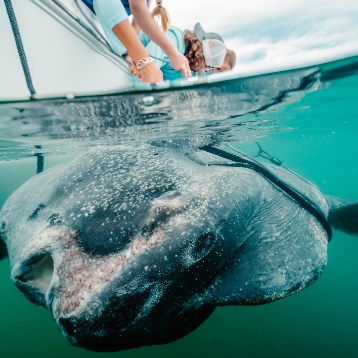Mola Mola Tagging and Sampling

DISCOVERY Yacht Calliope
Cape Cod, Massachusetts
August 9-15, 2022
Leadership
Research Team
Oliver Shipley Ph.D; Alexis Janosik Ph.D; Viktoria Bogantes Ph.D, Christine De Silva; Jamie Fitzgerald; Jack Garvey; Tony Gilbert; Elliot Sudal
Purpose of Research
The purpose of this research is to learn as much as possible about the Mola Mola (Ocean Sunfish). It is the largest boney fish in the world, yet almost nothing is known about this ocean giant.
Project Overview
From August 9-15th, 2022, The International SeaKeepers Society faciliated a research expedition in collaboration with Beneath The Waves, The Univeristy of West Florida, and The University of Miami. Over the course of the expedition, the team, led by Dr. Ollie Shipley, cruised from Hyannis, Massachusets to Chatham on the southeastern corner of Cape Cod, in search of Mola Mola. Eventually ending up stationed in Provincetown on the northern tip of Cape Cod, the team searched for, and found several mola mola inside Cape Cod Bay. A total of nine mola mola were tagged with satellite tags pop-off tags, as well as acoustic tags. Acoustic tags emit a ping with a unique frequency, which track the animals’ underwater movements via acoustic “listening station” arrays.
In addition to tagging each fish, body length measurements were taken, as well as GPS coordinates and water temperature. These giant animals are like floating ecosystems, hosting different types of parasites and algae, as well as micro organisms, and for that reason, swabs were taken of the mucous found on the skin, in the gills, mouth, and cloaca. The microbiome data will go toward research being conducted by scientists at the University of Miami. Finally, DNA from the animals, as well as environmental DNA was collected and will be studied by Dr. Alexis Janosik of UWF.
Application
This is only the start of what will be an ongoing research effort to learn more and more about these animals. The more we know about any species’ place and role in marine ecosystems, the more we learn about how the absence or over abundance of that species can negatively effect the delicate balance that is needed for a healthy ocean, and in turn, a healthy planet. additionally, any time we learn about any unique genetic traits that certain animals possess, we start to learn more about our own biology, giving way to possible medical applications.
Expedition Goal
The primary goal of this expedition was to tag and sample mola mola in their natural habitat, being the pilot expedition of this research initiative. The secondary goal of this expedition was to simply assess the feasiblility of researching live specimens of Mola Mola in the field. Both proved to be wildly successful.
Location
Cape Cod, Massachusetts
Partner Sites
Beneath The Waves, The University of West Florida - Janosik Lab
